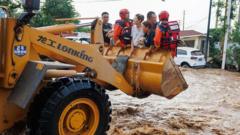At least 30 people have lost their lives in Beijing due to devastating floods, forcing the evacuation of over 80,000 citizens as relentless rains wreak havoc across northern China. Additionally, eight fatalities were reported from a landslide in Chengde, located three hours northeast of the capital.
China is grappling with a summer characterized by extreme climatic conditions, facing record heatwaves in the east and flooding in the southwest. In response, President Xi Jinping has urged comprehensive rescue operations and preparedness for the potential worst-case scenarios.
A budget of 200 million yuan ($28 million) has been earmarked for recovery initiatives, primarily centered on restoring vital infrastructure damaged by the floods. The hardest-hit areas include suburban districts on Beijing's outskirts like Miyun and Huairou, where roads have been submerged and power disrupted for over 130 communities.
Rescue efforts are ongoing, with videos capturing heroic teams wading through chest-high water to save trapped residents. One local, Yang, expressed her anguish as she is unable to reach her family in the severely impacted Miyun, fearing for their safety and that of her pets.
Residents described the rapid onset of the disaster, emphasizing how swiftly the floodwaters rose, leaving them scrambling for safety. This occurrence is a disturbing reminder of a similar deadly flood in July 2012 that claimed 79 lives in Beijing.
The current flood crisis is just one facet of widespread devastation across China this summer, with earlier instances of loss in regions like Shandong province due to Typhoon Wipha. Experts are increasingly linking such extreme weather events to climate change, highlighting the ongoing threat to both the populace and the economy, especially within the crucial agriculture sector.
Recent figures from China’s emergency management ministry estimate natural disasters have inflicted a staggering 54.11 billion yuan ($7.5 billion) in damages in the first half of this year, primarily driven by flooding incidents.
China is grappling with a summer characterized by extreme climatic conditions, facing record heatwaves in the east and flooding in the southwest. In response, President Xi Jinping has urged comprehensive rescue operations and preparedness for the potential worst-case scenarios.
A budget of 200 million yuan ($28 million) has been earmarked for recovery initiatives, primarily centered on restoring vital infrastructure damaged by the floods. The hardest-hit areas include suburban districts on Beijing's outskirts like Miyun and Huairou, where roads have been submerged and power disrupted for over 130 communities.
Rescue efforts are ongoing, with videos capturing heroic teams wading through chest-high water to save trapped residents. One local, Yang, expressed her anguish as she is unable to reach her family in the severely impacted Miyun, fearing for their safety and that of her pets.
Residents described the rapid onset of the disaster, emphasizing how swiftly the floodwaters rose, leaving them scrambling for safety. This occurrence is a disturbing reminder of a similar deadly flood in July 2012 that claimed 79 lives in Beijing.
The current flood crisis is just one facet of widespread devastation across China this summer, with earlier instances of loss in regions like Shandong province due to Typhoon Wipha. Experts are increasingly linking such extreme weather events to climate change, highlighting the ongoing threat to both the populace and the economy, especially within the crucial agriculture sector.
Recent figures from China’s emergency management ministry estimate natural disasters have inflicted a staggering 54.11 billion yuan ($7.5 billion) in damages in the first half of this year, primarily driven by flooding incidents.




















